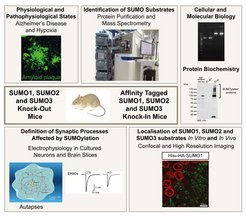Neuronal SUMOylation
SUMOylation is a post-translational protein modification akin to ubiquitination. It entails the covalent attachment of a small-ubiquitin-modifier (SUMO) protein to a lysine in a target protein, while SUMO isopeptidases remove SUMO from targets. Mammalian genomes contain four SUMO genes encoding SUMO1-SUMO4, of which SUMO4 has a specialized function. Based on sequence homology and other criteria, SUMOs are classified into two groups, SUMO1 and SUMO2/3. SUMOylation has very diverse consequences, including changes in protein solubility, stability, and interactions, operates in almost every cellular process, and is a key protein modification required by every eukaryotic cell.
Our work focuses on the role of SUMOylation in the regulation of normal and pathological neuronal function, with a particular emphasis on nerve cells synapses and synaptic transmission. We employ novel genetically modified mouse models for a systematic, quantitative, and functional analysis of SUMO1, SUMO2, and SUMO3 conjugation in neurons and of altered neuronal SUMOylation in prototypical physiological states and in pathophysiological states related to brain hypoxia and Alzheimer's disease.
By using knock-in mutant mice that express affinity-tagged SUMO1, SUMO2, or SUMO3, confocal and high resolution imaging, protein affinity purification, and mass spectrometry, we study the localization and identity of neuronal proteins that are conjugated to SUMO1, SUMO2, or SUMO3 in normal brain and in disease models. Selected SUMOylation substrates and the functional relevance of their SUMO conjugation are then studied using cell biological and electrophysiological methods. The systematic 'stock-taking' search for neuronal SUMOylation pathways in health and disease is complemented by a detailed analysis of neuronal and synaptic defects caused by SUMO loss. We expect that the functional defects detected in this context and the information on key neuronal SUMOylation targets obtained by our 'stock-taking' approach will converge to inform on key physiological and pathophysiological synaptic functions that are controlled by SUMOylation and on the SUMO targets involved.
The ultimate aims of our work are to provide a comprehensive catalogue of proteins that are conjugated with SUMO1, SUMO2, or SUMO3 in neurons and synapses, and to provide systematic insight into the key synaptic SUMOylation pathways and their function in health and disease.

